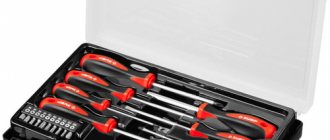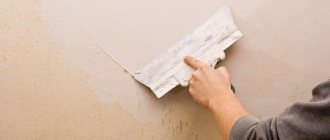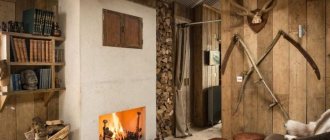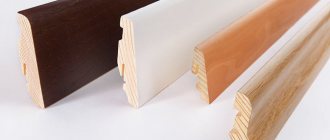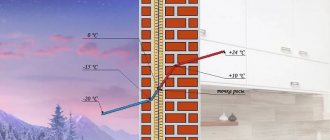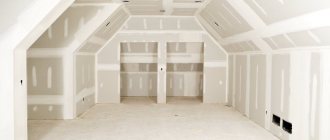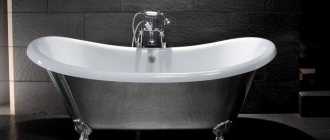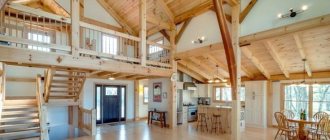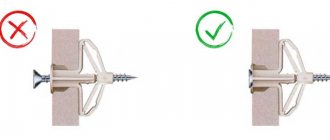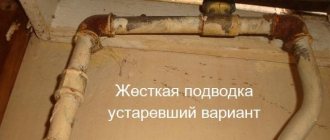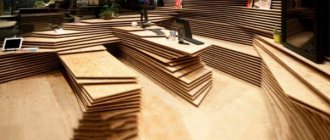Question from a reader of our portal: What non-combustible materials exist for finishing walls and ceilings?
Answer: Today, most building materials are made from synthetic components, which are not highly fire-resistant. Therefore, if the fire safety of your home is important to you, when choosing finishing materials you should pay attention, first of all, to fire-resistant materials.
What materials are these? In fact, there are several of them and they are divided according to the following criteria:
- insulators;
- insulation;
- non-combustible finishing materials for walls, floors, and ceilings.
In addition, fire-resistant materials differ from each other in how they transfer heat:
- maintaining temperature;
- heat reflective.
According to the form of release they are:
- leafy;
- panels;
- roll
Depending on the place of application, the materials are:
- for interior decoration;
- for outdoor installation.
So, we sorted out the classification. Let's now look at what finishing materials can perfectly withstand fire:
- Polyesters . This is a soft material synthesized from various types of polyesters and phosphorus compounds. Polyester materials are non-flammable, highly durable, and resistant to UV and infrared radiation. They are harmless to human health. When exposed to direct fire, polyester does not release toxic substances, but simply decreases in size;
- Carbons . We are talking about building materials obtained by carbon synthesis, and are characterized by high fire resistance and the ability to withstand ultra-high temperatures. Carbon materials are also durable and will not stretch or deform when exposed to fire;
- Silica . Products made from this material can withstand heat up to +2000 degrees C for some time! Silica is also a natural and environmentally friendly material;
- Quartz . Visually, such fire-resistant materials are similar to fiberglass, but they are much more durable and fire-resistant, and are able to retain their properties when heated to +1300 degrees C! It is noteworthy that the spacesuits of Soviet cosmonauts were made specifically from quartz fibers;
- Aramids . This is a fire-resistant type of polymer. Due to the transverse and longitudinal stitching, a fireproof soft and durable material is obtained that can withstand temperatures up to +370 degrees C;
- Asbestos . This group of materials is made from thin fibers of asbestos origin, and is able to withstand fire at temperatures up to +500 degrees C. However, asbestos is considered a material harmful to health, so it is better not to use it as a non-combustible material for finishing walls in a residential building. It is good as a cladding material for exterior work, as well as cladding of non-residential premises (garages, boiler rooms, gazebos, hangars, electrical panels, etc.);
- Cement particle boards . This non-flammable material is highly resistant not only to fire, but also to moisture. That is why it is widely used today in the construction of building frames, as well as for leveling floors, erecting partitions and other purposes;
- Gypsum particle boards . They are considered more environmentally friendly and beautiful analogues of cement-bonded particle boards. Although they have slightly lower fire resistance and a higher price;
- Non-flammable HPL panels . These are specially designed fire-resistant boards, the main material is vermiculite. It differs from the previous ones in that the edges of the product are better protected from fire, plus such panels look even better - if desired, you can order slabs with an imitation of the texture of natural wood. Non-flammable HPL materials are harmless, hygienic, highly fire-resistant and moisture-resistant;
- Fire-resistant GVL . This is the “good old” plasterboard, but with the addition of special additives that increase its fire-resistant qualities, due to which such a plasterboard sheet can withstand fire for up to 30 minutes. Externally, such drywall differs from ordinary gypsum plasterboard sheets in its characteristic gray color;
- Fiberboards . This material is made from wood fibers, which are first compressed with a press, after which cement and a special binder mixture are added inside. Thanks to this technology, non-flammable slabs are obtained, which are also excellent sound insulators;
- SKL panels . They are produced from calcium silicate raw materials. They are distinguished by their light weight, high strength and high ductility, in addition, they are safe for health. SKL panels can be used for finishing any premises, including bedrooms, baths and swimming pools;
- Gypsum fiber sheets (GKL) . These fire-resistant materials are made from compressed cellulose. Today, gypsum plasterboards are widely used in home decoration due to their low price, strength, durability and moisture resistance. Such sheets are used to cover walls, level floors, and build suspended ceilings;
- Oriented Strand Boards (OSB) . They are made by mixing wood chips and adhesive resin under high pressure. OSB boards are distinguished by excellent strength indicators with a small thickness (from 6 mm) - according to this indicator, they are 300% stronger than MDF and chipboard! What is characteristic is that with such a thickness, OSB retains its flexibility, which is why they are often used for cladding bay windows, attics, verandas and gazebos. Such slabs are extremely popular in suburban construction today.
Of course, this is not the entire list of building materials that are not afraid of fire. Today there are many more of them produced. Yes, what can I say, “good old” ceramic brick is the most fire-resistant material, since it can withstand temperatures of 1000 degrees C and higher.
Fire resistance of building materials
Facing materials differ in chemical composition, structure, thermal insulation, and hygroscopic properties. Depending on the raw materials from which they are made, the following materials are distinguished:
- organic;
- inorganic;
- mixed.
Non-flammable (NG) are inorganic materials: stone, brick, glass, asbestos cement and others. When organic and polymeric substances are added, the properties of the product change. NG include:
- inorganic materials permitted in construction;
- metals;
- gypsum boards containing 8% organic matter;
- mineral wool boards - 6% binder components.
Refractory materials contain 8–15% filler. All other organic materials are considered flammable.
How fire danger is measured
Methodological materials on life safety
According to GOST standards on the fire hazard of materials, all products for construction are divided into several categories. There are only two main groups: combustible (G) and non-combustible (NG) materials. Non-combustible products (natural stone, cement, glass) do not smolder or burn, therefore they are considered as a single group. But materials from category “G” are divided into subgroups according to a number of characteristics:
- Flammability (four groups from G1 to G4);
- Speed of fire spread over the surface of the material (RP1-RP4);
- Flammability (B1-B3);
- Smoke formation (D1-D3);
- Toxicity (T1-T4).
Materials marked G4, E4, D3 and RP4 are the most dangerous in a fire - they quickly flare up and completely burn out, releasing acrid smoke and harmful toxins that can cause poisoning or death.
Furnace lining materials
Lining is the lining of the furnace surface that is in contact with the flame. But since, in addition to protection, it can reduce heating efficiency, it is important to calculate the thickness of the layer.
Heat-resistant materials are installed during the construction of the stove or during its finishing.
Examples of furnace lining Source yandex.net
Lining material:
- fireclay products;
- leaf kaolins;
- mullite mats;
- basalt wool;
- vermiculites;
- fire-resistant compounds.
The same applies to cast iron stoves - they get very hot, so the walls near them must be protected, especially if the stove is installed in a wooden house.
Non-combustible wall panels
Human safety is paramount. After all, no amount of money can buy life, but no one is immune from unforeseen circumstances. Therefore, you need to choose safe materials for finishing. For example, non-flammable panels for interior decoration. A fire in an apartment or house can start due to old wiring or a forgotten iron from a gas stove in the kitchen. But if non-flammable panels are used in the finishing, then a fire can be avoided.
Wall and ceiling cladding near heating units
Safe distances for factory furnaces are indicated in the passport. Based on these data, a protective screen is made behind the stove. For installation, use basalt insulating cardboard. This fire-resistant material for finishing walls under a stove is easy to cut and bend, and does not emit harmful substances in the event of a fire. Sheets of basalt fiber are installed end-to-end with the reflective part inside the room.
Important! A gap of 5–10 cm is left between the ceiling and the screen for shrinkage of the house.
The screen should protrude 20–30 cm to the left and right of the stove. The protective casing is made of fireclay and red stove material 0.5–0.25 bricks thick. The floor near the stove is covered with a sheet of stainless steel, galvanized or porcelain stoneware.
The stove firebox is located low to the floor. In this case, it is protected with ceramic tiles.
The protective gasket should protrude 100 mm beyond the perimeter of the heating unit. Floor stainless steel sheets 600x800 mm cost 1,200 rubles.
A metal sheet is laid if the stove has a high base Source its-sauna.ru
Before lining the furnace, the following work is carried out:
- They build a base 170x70x145 cm. The first layer (15 cm) in the foundation is sand, the second 20 cm is stones, the third 10 cm is crushed stone. The foundation for the stove should be 20 cm below the finished floor.
- Brick, heat-insulating material, and a sheet of metal are laid on the base.
- Ceramic tiles are laid on the finished floor.
- Install the stove.
- Construct a fence of bricks.
Heating efficiency and home safety also depend on proper installation. Heat-resistant materials are used for the chimney: brick, stainless steel, asbestos-cement, ceramic, sandwich pipes.
Before installing the pipe in the ceiling, a square of 1.0 x 1.0 m is cut out. The inside is sheathed with mineralite sheets. The pipe is protected with a box if it runs next to joists and rafters. The inside of the protective frame is also lined with mineralite slabs.
See also: Catalog of companies that specialize in the installation of fireplaces and stoves.
Installation work on installation of non-combustible finishing panels
All non-combustible panels are mounted on walls in two ways - with fastening to a frame, or with fixation directly to the surface, that is, using frame or frameless technology. To decide which installation option is best suited for a particular surface, it is advisable to familiarize yourself with both cladding methods.
Installation of panels on a frame structure
To create a frame and attach panels to it, special steel or aluminum profiles are used to cover the joints and corner parts of the junction of the slabs. Moreover, the outer profiles are painted with polymer compounds selected from the RAL catalog, which allows you to ideally combine the color of the frame and the mounted slabs, creating a surface completely protected from external influences.
The metal parts of the frame have standard length dimensions, which are 3000 mm for aluminum profiles, and 2500, 2700, 3000, 3300, 3600 mm for those made of galvanized steel.
Aluminum guides of various types for frame fastening of non-combustible panel trim
To understand in what area and for what purpose this or that frame element is used, it is recommended that you familiarize yourself with the installation diagram presented for the sample and the table below. They show the main connecting nodes used to install non-combustible finishing panels.
Basic principles of fastening finishing panels to a frame structure
| Profile design | Name and scope of the profile |
| The PS profile is a common rack profile, also used for plasterboard work. Creates a load-bearing base for the frame - these are the racks that are attached to the wall surface. The PS profile is completely hidden by the cladding, that is, its appearance does not matter - the usual galvanized version can be used. | |
| The “omega” connecting profile is used to press the panels against the guides (PS profiles) fixed to the wall. Used in combination with the Pi-profile. | |
| Pi-profile, serving as a kind of plug for the connecting profile. It is inserted into the “omega” profile after securing it to the PS profile, thereby covering the fasteners. | |
| The L-profile is intended for joining slabs at internal corners. | |
| F-profile is used for neat and even connection of panels at external corners. |
The peculiarity of using these profiles for mounting slabs is that the panels are not damaged when they are fastened, but are clamped between two profiles. The profiles themselves are attached to the guides of the frame, assembled from a PS profile, installed vertically or horizontally and secured with metal screws. Due to the fact that the design is not only reliable, but also easy to disassemble, access to all communications hidden behind the panels will always be provided, since removing a panel fixed in this way will not be difficult.
Mutual pairing of PS, “omega” and “pi” profiles when fixing adjacent wall panels
Installation of the facing structure is carried out in stages, in the following order:
Frameless method of installing non-combustible panels
This technology for fixing slabs can only be implemented if the surface to be tiled is perfectly leveled, since the slabs will be glued directly to the wall.
The process of installing panels without using a frame is carried out in the following sequence:
It is clear that most often this installation method is used when slabs without a decorative coating are selected. In principle, this is not even finishing in the direct sense of the word, but rather one of the preliminary stages of preparation for it, associated with leveling the surface of the wall. But on this non-flammable, flat surface it is already possible to carry out any intended finishing.
In conclusion, it should be noted that many owners of houses and apartments do not even imagine the existence of non-combustible panels for interior decoration. And some of those who are aware of the availability of such products, for some reason, do not seriously consider them as a finishing material for residential premises. And it’s completely in vain, since the panels have many clear advantages over other types of wall cladding.
By choosing non-flammable decorative boards, you can solve several problems that arise during the repair process in one fell swoop. This is to significantly reduce the time for carrying out repair work, save yourself from large-scale cleaning, hide some engineering communications behind the cladding, additionally soundproof and insulate the walls, and also save some money, since in most cases additional finishing is no longer needed.
At the end of the publication, we invite you to watch an interesting video about the advantages of non-combustible finishing panels:
Thermal insulation boards PIRRO
The Russian company PirroGroup produces non-combustible materials for finishing walls and ceilings. Thermal insulation boards based on polyisocyanurate foam have a closed cell structure that is filled with gas. The material does not support combustion due to its special design and composition.
Comparison of thermal conductivity indicators of Pirro fire-resistant board and other materials Source e-uteplitel.ru
PIR-boards PirroThermo are designed for insulation of walls and ceilings in baths. The thermal insulation material is lined on both sides with aluminum foil. Flammability class of panels G1-G2. PirroUniversal has a double-sided aluminum cladding. Price: 432 RUR/piece.
To protect the house, materials are used that have different characteristics and composition. We list the heat-resistant products that are used indoors:
- Drywall sheet.
- Terracotta tiles.
- Basalt fiber panels.
- Roll materials.
Fire resistant fabrics
Wall decoration can be done with classic drapery. The existing fireproof fabric, practically indistinguishable in appearance from conventional woven materials, allows you to embody any ideas of designers.
The material is made by weaving polymer fibers. Fire retardant impregnation gives the products non-flammable qualities. Fire-resistant woven materials are used for finishing the walls of any premises, car interiors; They are used to make professional clothing for firefighters, rescuers, and metallurgists.
Fire retardants can impart non-flammable properties to almost any material. The effect is due to the ability to absorb the thermal energy of the flame, spending it on melting the fire retardant additive. Plus, gases are released that do not support combustion.
Fireplace cladding
Fireplaces are lined with stone, fireclay, marble, ceramic tiles and other non-combustible materials. When decorating a fireplace with natural stone, an additional foundation is made.
To decorate fireplaces, they use natural stone soapstone, which can withstand loads and is heat-intensive. Plates made from this material:
- protect stoves, fireplaces, chimney ducts;
- lining the walls and floor of the bathhouse;
- They make heated floors and walls with electric cables.
The stone was first mined in Finland. Talkomagnesite can withstand heating and cooling without losing its shape or color. Lining the stove with stone creates a healthy microclimate in the room and saves fuel. The technology for lining stoves came from Finland.
Price of the stone: 8000 rubles (sq. meter).
Thermal boxes for fireplaces are assembled and adjusted in production. Various shades of marble are used for installation. The protective casing is made according to individual projects, and ready-made claddings can be selected on the manufacturers’ websites.
Reason #6. Lack of light or direct sunlight
gardeningknowhow.com
Incorrect placement can also cause leaf tips to turn black. Moreover, both too bright light (direct sunlight) and lack of lighting lead to a similar result.
When trying to understand why the leaves of flowers dry out, it doesn’t hurt to analyze whether direct sunlight burns the plant. This provokes the appearance of not only brown tips, but also entire spots. This phenomenon occurs especially often after spraying on a sunny day.
Yellowing due to lack of light looks different. It manifests itself as an uneven loss of color and may be accompanied by the dropping of leaves (hibiscus behaves this way most often).
- Find out which window (north, east, southwest, etc.) the flower prefers to grow on, and try to find a suitable place for it.
- If it is not possible to place the pot on a bright window, get an additional lamp. This can be a special phytolamp or a regular fluorescent one.
- If the leaf tips are turning yellow on only one side of the flower, try rotating the pot from time to time to ensure all shoots receive enough light.
- Protect the plant from bright sunlight using blinds or regular cardboard (its size should correspond to the height of the flower), which should be placed between the window and the flower pot during the daytime.
Heat-resistant boards Aditim
The multidisciplinary holding offers non-flammable materials:
- Pyrocol glue;
- sealants, mastics;
- panels;
- foam;
- fire brick.
Fire-resistant adhesive is intended for bricklaying. Pyrocol glues panel and sheet materials, ceramic fibers, mineral wool and glass wool. If fire-resistant glue is used, the heating unit will be ready within 24 hours. Pyrocol increases the fire resistance of the elements to which it is applied.
Fibrodice MS panels are made from inorganic materials and do not contain formaldehyde or asbestos. Eco-friendly products are used for flooring and ceiling coverings.
Fire-resistant panel Fibrodice MS Source saunainter.com
Fireproof Odiboard sheet contains mineral fibers, expanded perlite, and binders. The products are convenient to use and easy to process. The panels are made in different sizes:
- 900x2100 mm;
- 1200x2100 mm;
- 1200x2400 mm.
The company produces Oditec panels made on the basis of calcium silicate. The material is used in fireproof structures. The fire resistance class of Aditim/Odice panels is A 1.
Non-combustible wall panels, installation work
The work is not difficult, but it requires following some instructions and recommendations. The scheme is as follows:
There are manufacturers who produce non-flammable decorative panels for walls and special aluminum guides that simplify installation.
This way you can install non-flammable panels in a house, apartment or any other room. If you have no skills in such work, then it is better to use the services of professionals. The panels will protect against unforeseen circumstances and will last for decades.
Source
Superisol sheets for wall insulation
Skamol is a supplier of insulation systems for construction. The organization offers a wide range of products. S-Isol WR is used for lining chimneys, duct construction, and wall insulation.
When attaching, use screws or glue. S-Isol WR is a lightweight insulation board with high strength and heat resistance. The product is designed for 1100 ⁰С. On the construction market you can choose slabs of different sizes. Sheet thickness is 25–80 mm. The price of 1 sheet depends on the size, 2950–14700 rubles.
Superisol boards are easy to cut and light weight Source kamin.md
Preparing the soil for potato seedlings
The soil for potato seedlings should be loose, water- and breathable, that is, approximately the following composition: to 6 parts of turf soil or 4 parts of high-moor peat add 2 parts of garden soil and 1 part of sand. The ingredients are thoroughly mixed, the soil mixture is spilled to protect against soil fungi with a solution of Trichodermin or Fitosporin-M, prepared in accordance with the instructions, and 10-15 g of Nitrophoska is added for every 10 kg of substrate. Biological products Trichodermin and Fitosporin have the property of not only destroying pathogens, but also promoting the proliferation of microflora beneficial to plants. After treatment with biological products and application of fertilizer, the soil mixture is thoroughly mixed again and dried at room temperature.
Minerite slabs
Cement-fiber board is used for cladding building facades. The impact-resistant plate is safe for health. Minerite - fireproof materials for walls around stoves are often used in baths and saunas. The composition of mineralite includes:
- cement;
- cellulose;
- mica;
- limestone.
Several types of fiber cement boards are produced:
- Windproof windshields are installed in façade frames.
- HD are universal products that are used for interior and facade work. They produce HD slabs of different thicknesses from 3.2 to 10 mm.
- “Pastel” slabs have a polished surface and are painted.
- The PC model is covered with façade primer and painted.
- Fire-resistant boards - for lining and protection of heating equipment.
Non-flammable sheet material is used for thermal insulation of the floor, walls, ceiling, and roof in the bathhouse. The dimensions of the mineralite sheet are: 1200x630; 1200x845; 1200x1275mm. Maximum heating up to 400 degrees. Price of sheets: 945, 1265, 1885 rubles.
Fiber cement boards Source stroyfora.ru
Foam glass - what is the difference and how is it used
An equally worthy option is non-flammable thermal insulation based on foam glass (cellular glass). Visually, the material resembles frozen soap foam with a special porous surface.
It is produced by sintering glass chips with a gas-forming agent, usually coal.
Compared to the main advantages of the material, the disadvantages seem insignificant. These include instability to mechanical damage and high weight.
It is advisable to use foam glass for insulating basement walls that are not subject to mechanical damage. The service life of the material declared by the manufacturer is more than one hundred years.
paints and varnishes
Fire-resistant paint combines protection and decorative properties. It forms a film that keeps objects from burning. Water-based and organic-based paints with swelling effect are used for metal surfaces. One of the advantages is that it can be removed from the surface.
Fire-resistant fillers in paints:
- vermiculite;
- perlite;
- stone wool;
- basalt fibers.
During testing, the fire protection group of the product is determined. When interacting with fire, the intumescent layer increases 70 times. This creates a coke layer that protects the object. As the paint disintegrates, it releases components that slow down the combustion process.
When choosing paint, pay attention to the cost and material of the surface used.
The following paints are available for sale:
- NEOMID for metal (6 kg) costs 1,714 rubles.
- NEOMID for air vent (6 kg) – RUR 1,714.
- NEOMID for cable (6kg) – 1985 rub.
- NEOMID for wood (25 kg) – 8039 rub.
- Thermal barrier for metal structures – 375 rubles/kg.
- FRIZOL-OK for metal (25 kg) – 5750 rub.
- Protect F for metal structures (20 kg) – 4050 rub.
- Pirocor for metal – 250 rub/kg and others.
Fireproof paint Source nebezopasno.com
All paints are applied with brushes, rollers, and sprayers. The manufacturer indicates the layer thickness and recommended primers on the packaging.
Thermal paint application
Fire-resistant wall paint contains fillers and pigments. A non-flammable composition for wall finishing, after hardening, forms a film that performs protective and decorative functions. Thermal paint is an inorganic complex of alkali metal and silicon oxides.
Talc, special types of clay, and mineral fibers are used as fillers. There are two components offered for sale that must be combined and mixed before use. The resulting non-flammable mixture should be used within a maximum of 12 hours.
There is fire-resistant paint intended for interior surfaces, in particular walls, as well as for exterior coatings.
Briefly about the main thing
Construction stores have a lot of non-flammable materials suitable for finishing work. They are durable and easy to install, meeting fire safety standards.
When choosing protection for walls, you need to choose environmentally friendly materials. Natural stone and decorative cladding products are on sale. You can further increase the fire resistance of structures by painting them with special paints. Fire-resistant paint and varnish products are available in different price segments.
Ratings 0
Mineral wool fire retardant products
Mineral wool fibers are able to withstand temperatures above 1000°C without melting. In the process, at temperatures above 250°C, the binders of the material evaporate, and the fibers, due to chaotic adhesion, provide cohesion and sufficient strength, creating protection from fire.
Mineral wool fire retardant products
Mineral wool fire-retardant materials are successfully used for insulating fireplace and stove pipes, external walls, roofs, and floors.
Tissue NG
Non-flammable fabrics are widely used in construction; they are made from the following types of raw materials:
- Polyesters. The threads are synthesized from various polyesters and phosphorus compounds. Weaving - any: from jocquard to velvet. Fabrics are characterized by non-flammability, strength, resistance to ultraviolet and infrared radiation, and safety for human health. When exposed to direct fire, it shrinks in size but does not release toxins.
- Carbon. These are materials obtained by synthesis. They consist only of carbon and are characterized by high fire resistance. For example, filaments of electric lamps are made from such materials. In addition, these NGs are resistant to chemicals, stretching, deformation and temperatures above +300 degrees C.
- Silica. Similar to quartz fabrics. Resistant to temperatures, temporarily able to withstand up to + 2000 degrees C. Environmentally friendly fabric, even filters are made from it.
- Quartz. Fibers are drawn from the mineral at high temperatures. Externally, the material resembles fiberglass, but can withstand heating of more than +1300 degrees C, while the properties do not change. The fabrics were used to make spacesuits for Soviet cosmonauts.
- Aramid. This is a polymer product. The plastic has transverse and longitudinal stitching. It is produced using different technologies and has different characteristics depending on the specific technique. The weave of the fabric can be different. The product can withstand temperatures up to +370 degrees C and is very durable. The list of aramid materials is constantly expanding.
- Asbestos. This group is made from fine fibers of natural silicates. It can withstand heating up to temperatures up to +500 degrees C and has good insulating parameters. But asbestos is not safe for human health, so it should not be used as a non-flammable material for finishing walls in a residential building or office, or for other interior work. It is good for external cladding and for cladding special premises, for example, boiler rooms, garages, hangars, gazebos, electrical panels and other objects.
Universal fire-resistant NG
What determines the spread of a fire?
The causes of a fire can be different, but the spread of fire depends entirely on the number of flammable materials in the building and the access to oxygen.
Using as many non-combustible materials as possible in your home helps reduce the risk of fire and makes fire and smoke more easily controlled. The determining factor in whether a small fire will spread to the rest of the building is how adjacent materials will react to the fire.
The main problem with combustible materials remains toxic smoke and the rapid spread of fire. Much also depends on the concentration of synthetic components on a certain section of the wall or ceiling. At a sufficiently high concentration, it becomes unsafe for a person to be in such conditions. Statistics show that inhaling toxic smoke causes more deaths than the fire itself.
Currently, manufacturers are trying to test all their products for fire resistance. This reduces the amount of materials that could cause a fire.
Don't forget to add the Nedvio website to your Bookmarks. We talk about construction, renovation, and country real estate in an interesting, useful and understandable way.
Definition
Non-combustible materials are products that, when exposed to flame, sparks, high temperatures, electric current, or chemical reactions, do not ignite, do not smolder, do not spread fire, or emit smoke. There are natural and artificial materials. In addition to fire-fighting qualities, other parameters are also important for building materials:
- deformation when wet;
- deformation when heated;
- heat conductivity;
- degree of moisture absorption;
- bending strength in dry and wet conditions;
- density;
- strength;
- tensile strength;
- specific viscosity.
Additional qualities determine the possibility of use for certain purposes.
Rolled refractory materials
Internal impregnations
The main reason for using special impregnations in baths and saunas is increased levels of humidity and temperature, which can cause destruction of wooden ceilings, walls and shelves.
When choosing an impregnating material suitable for these purposes, the main attention is paid to the quality of the composition, after application of which the wood should not lose the ability to “breathe” freely. You should also distinguish between the types of compounds used to protect shelves and benches from similar materials used when treating walls and ceilings in a bathhouse
You should also distinguish between the types of compounds used to protect shelves and benches from similar materials used when treating walls and ceilings in a bathhouse.
Impregnation for shelves
The protective agents used to treat shelves, based on their effect on the color of the wood, are divided into colorless and colored. The first includes impregnations of various compositions, bleaching mixtures, varnishes and waxes. Varnishes for the protective coating of shelves in saunas and baths must be subject to strict selection, during which special brands that release toxic substances when heated are eliminated.
Typically, for benches and shelves in a bathhouse, water-based compounds are used that penetrate well into the wood structure.
Colored coatings are used in cases where darkening of previously treated areas is observed. In this case, only the tarnished parts of the surfaces are subject to coating, but if desired, they can be completely treated.
As for specific samples of protective material, acrylic varnishes from these or “Belinka” are suitable for treating baths and saunas. All of them are made on a natural basis and have a large selection of color shades.
Protective coatings for walls and ceilings
Impregnations intended to protect walls and flows in the bathhouse must have an organic base and have water-repellent properties.
Modern processing agents have universal properties and are able to protect surfaces from moisture and thermal heating, as well as from the destructive effects of fungi and insects.
Depending on their base, all known types of protective impregnations are divided into water-based and oil-based preparations. Complex (combined) compositions, produced in the form of paints and varnishes, are also very popular, providing protection for the finishing materials of the bathhouse from moisture fumes and microorganisms.
Some of them have additional features such as fire resistance and the ability to repel dirt.
Carpets
They can also be artificial and natural. Currently, the former are more common. They are moisture resistant, do not fade from the sun, are inaccessible to rodents and moths, and are easy to care for.
There are a lot of options for carpet flooring, and, accordingly, their qualities and characteristics are very diverse. Acrylic carpets, nylon, wool, polypropylene, plant fiber, silk and many others are produced. They also produce carpet tiles that provide easy and simple installation on and removal from the base. There are also a lot of color options.
The service life of carpet is no more than 5 years. It accumulates dirt, dust and is a good habitat for dust mites.
Metal siding
The safest fire-resistant facades are metal types of siding.
Metals have high thermal stability and do not ignite at very high temperatures.
Metal siding panels are offered in a wide range of different sizes, shapes and textures. Some types of non-combustible metal siding qualitatively imitate timber, brick or natural stone.
Each has several layers, among which the base (middle) is steel with a thickness of 0.35 mm to 0.65 mm. From it in the outer direction follows a zinc coating, a mineral film of phosphates, a primer and a polymer lining made of polyesters, polyurethanes, plastisols or other synthetic products.
In the inner direction from the steel core there are layers of zinc coating, phosphate protection, and paint.
The service life of multilayer steel siding largely depends on the composition of the facing polymer. Polyester will last unchanged for about 20 years, plastisol - more than 30 years, a product labeled PVDF will not change for half a century.
The thickness of the organic layer varies from 25 microns for smooth products to 200 microns for embossed non-flammable products. The color fastness and inertness to atmospheric influences of all types of metal siding is pleasantly surprising and has the highest ratings on the international scale.
In addition to steel, aluminum is used to produce non-combustible siding. Industrial pavilions, trade tents, and social institutions are usually covered with such sheets.
The material is characterized by high fire resistance, low weight, and inertness to atmospheric influences. The only thing that is disappointing is the not very high mechanical strength of aluminum sheets. It's certainly not steel. As a result of sharp impacts, the beauty of non-combustible cladding can be noticeably damaged.
Varieties
Non-combustible building materials are classified according to several criteria. By purpose they are distinguished:
- insulators;
- for insulation;
- non-combustible finishing materials for walls, floors, and ceilings.
In addition, the products differ from each other in the way they transfer heat:
- temperature-resistant due to physical and chemical properties;
- materials that reflect heat.
By release form:
- leafy;
- panels;
- roll
By place of use:
- for interior decoration;
- for installation outside buildings and structures.
Important! In addition to the basic fire-fighting properties, fire-resistant products may have additional parameters. For example, moisture resistance allows it to be used in the kitchen, bathhouse or swimming pool. High sound absorption rates allow the material to be used for insulating music studios, cinemas and other facilities.
Fireproof fireproof panels "Gypsoacryl"
